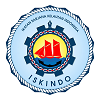KEANEKARAGAMAN HASIL TANGKAPAN SONDONG DI PERAIRAN LAUT KUALA TUNGKAL KABUPATEN TANJUNG JABUNG TIMUR
Abstract
ABSTRACT
The purpose of this research to examine the diversity of the catch of the sondong fishing gear, which includes: main catch, by-catch and discard. The research was conducted in the waters of Kuala Jambi in May 2020. Sampling of the catch of sondong fishing gear was carried out using the purposive sampling method using 4 sondong boats that made 8 trips.. The research data obtained 32 species consisting of 6 species of Main catch, 7 species of By-catch and 18 species of discard. The composition of the catch consisted of 43.4% main catch, 5.2% by-catch and 51.4% discard. From the research results, it can be concluded that the sondong fishing gear is classified as non-environmentally friendly fishing gear.
Key words: Sondong, Main Catch, By-catch, Discard
ABSTRAK
Penelitian ini bertujuan untuk mengkaji keanekaragaman dari hasil tangkapan alat tangkap sondong, yang meliputi : hasil tangkapan utama, sampingan dan buangan. Penelitian dilakukan di perairan laut Kuala Jambi pada bulan Mei 2020. Pengambilan sampel hasil tangkapan alat tangkap sondong yang dilakukan dengan menggunakan metode purposive sampling dengan menggunakan 4 buah kapal sondong yang melakukan penangkapan 8 trip. Data hasil penelitian mendapatkan 32 spesies yang terdiri dari 6 spesies merupakan Main catch, 7 spesies By-catch dan 18 spesies discard. Komposisi hasil tangkapan terdiri dari 43,4 % main catch, 5,2% By-catch dan 51,4% discard. Dari hasil penelitian dapat disimpulkan bahwa alat tangkap sondong tergolong alat tangkap tidak ramah lingkungan.
Kata kunci : sondong, utama, sampingan dan buangan
Full Text:
PDF (Bahasa Indonesia)References
Akrimi dan Subroto, G. (2002). Teknik Pengamatan Kualitas Air dan Plankton di reservat Danau Arang-arang Jambi: Teknisi Litkayasa Pratama, Teknisi Non Klasifikasi Balai Riset Perikanan Perairan Umum. Palembang, Buletin Teknik Pertanian, 7(2), 54-57.
Bengen, D. G. (2002). Sinopsis Ekosistem dan Sumberdaya alam pesisir dan laut serta prinsip pengelolaannya. Pusat Kajian Sumberdaya Pesisir dan Lautan IPB: Bogor, 63.
Chan, T.Y. (1998). Shrimps and prawns. 851-971. In Carpenter, K.E. and V.H.Niem (eds). FAO species identification guide for fishery purposes. The living marine resources of the Western Central Pacific. 2. Cephalopods, crustaceans, holothurians and sharks. Rome, FAO. 687- 1396.
Eayrs S. (2005). A Guide to Bycatch Reduction in Tropical Shrimp-Trawl Fisheries. Rome, Italy: Food and Agriculture Organization (FAO) of the United Nations.
Hall, M.A., Alverson, D.L., Metuzal, K.I. (2000). By-catch; Problems and Solutions: Seas at Millennium: An Environmental Evalua-tion. In: Sheppard, C.R. (Ed.), Global Issues and Processes.
Harrington, J. M., Myers, R. A., & Rosenberg, A. A. (2005). Wasted fishery resources: discarded by‐catch in the USA. Fish and fisheries, 6(4), 350-361.
Hutabarat, S. & Evans, S. M. (1985). Pengantar Oseanografi. Jakarta: UI-Press.
Ihsan, N. (2009). Komposisi Hasil Tangkapan Sondong Di Kelurahan Batu Teritip Kecamatan Sungai Sembilan Kota Dumai Provinsi Riau. Skripsi. Fakultas Perikanan Dan Ilmu Kelautan Universitas Riau. Pekanbaru.102 hal.
Laevastu, T. Hayes, M.L. (1981). Fisheries Oceanography and Ecology. England: Fishing News Book Ltd. Farnham-Surrey.199 hal.
Nofrizal, Jhonnerie, R. Yani, A. H., Alfin. (2018). Hasil tangkapan sampingan (bycatch dan discard) pada alat tangkap gombang (fulter net) sebagai ancaman bagi keslestarian sumber daya perikanan. Marinr Fisheries 9(2):221-233.
Supriharyono. (2000). Pelestarian dan Pengelolaan Sumber Daya Alam di Wilayah Pesisir Tropis. Gramedia Pustaka. Jakarta.
DOI: https://doi.org/10.21107/jk.v14i2.9147
Refbacks
- There are currently no refbacks.

This work is licensed under a Creative Commons Attribution 4.0 International License.

Jurnal Kelautan by Program Studi Ilmu Kelautan is licensed under a Creative Commons Attribution 4.0 International License.
Published by: Department of Marine Sciences, Trunojoyo University of Madura













